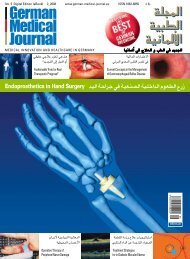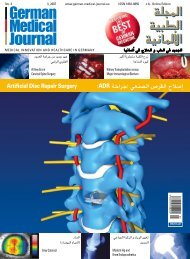جراحة الصمام الأبهري - the German Medical Journal
جراحة الصمام الأبهري - the German Medical Journal
جراحة الصمام الأبهري - the German Medical Journal
You also want an ePaper? Increase the reach of your titles
YUMPU automatically turns print PDFs into web optimized ePapers that Google loves.
Lung Transplantation<br />
250th Lung Transplantation<br />
at <strong>the</strong> Clinic of <strong>the</strong> University of Munich<br />
F E A T U R I N G T H E B E S T O F G E R M A N M E D I C I N E<br />
زرع الرئة<br />
زراعة 250 رئة يف جامعة<br />
ميونخ<br />
At <strong>the</strong> end of June 2006 <strong>the</strong><br />
clinic of <strong>the</strong> university celebrated<br />
a jubilee: The 250th lung<br />
was transplanted. In October<br />
1991 a lung was transplanted<br />
for <strong>the</strong> first time in Großhadern.<br />
In 1999 already <strong>the</strong> 100th<br />
transplantation was accompplished.<br />
Today approximately<br />
30 operations are carried out<br />
every year. During <strong>the</strong> 14 years<br />
since <strong>the</strong> first transplantation<br />
much has changed.<br />
The results of <strong>the</strong> operations<br />
have improved considerably<br />
(90% of <strong>the</strong> patients survive<br />
<strong>the</strong> first year after <strong>the</strong> operation),<br />
fur<strong>the</strong>rmore, donor<br />
organs can be preserved in<br />
a much better way, i.e. <strong>the</strong>y<br />
fail more rarely and function<br />
better. Also, <strong>the</strong>re have been<br />
advances with medication that<br />
suppress <strong>the</strong> immune defence<br />
of <strong>the</strong> body, thus preventing<br />
<strong>the</strong> new organ from being<br />
rejected. Assistant professsor<br />
Rudolf Hatz MD, senior<br />
physician at <strong>the</strong> surgical clinic<br />
and head of <strong>the</strong> Munich lung<br />
transplantation group was<br />
quoted as saying, “Today we<br />
see transplant reactions clearly<br />
more rarely. Moreover, we are<br />
able to diagnose <strong>the</strong>m considerably<br />
faster and react to<br />
<strong>the</strong>m accordingly”.<br />
The most frequent reason why<br />
patients need a new lung is <strong>the</strong><br />
chronic obstructive pulmonary<br />
disease by which <strong>the</strong> organ<br />
does not function any more<br />
due to <strong>the</strong> unnatural extenssion<br />
of pulmonary alveoli (tiny<br />
gas-exchange sacs). Contrary<br />
to kidney failure, in which case<br />
<strong>the</strong> function of <strong>the</strong> organ can<br />
be replaced by kidney dialysis,<br />
or cardiac failure, where an<br />
artificial heart can be applied,<br />
<strong>the</strong>re is no artificial substitute<br />
for <strong>the</strong> lung. “Currently <strong>the</strong>re<br />
are 52 patients on our waitiing<br />
list for a new organ”, says<br />
assistant professor Rudolf Hatz<br />
MD. “Unfortunately, we are<br />
still short of donor organs in<br />
<strong>German</strong>y, so that about 15%<br />
of <strong>the</strong> patients must die duriing<br />
<strong>the</strong> waiting period”. Men,<br />
women, and children who are<br />
listed with high urgency wait<br />
three to four months on averaage,<br />
whereas o<strong>the</strong>r patients<br />
wait up to 18 months. This<br />
waiting period is a very difficcult<br />
time for patients: Most of<br />
<strong>the</strong>m constantly need to carry<br />
an oxygen cylinder along and<br />
many o<strong>the</strong>rs can hardly walk<br />
around due to <strong>the</strong>ir breathing<br />
problems.<br />
Assistant Prof. Rudolf Hatz (MD)<br />
Surgical Clinic, Munich University<br />
Clinic Großhadern<br />
rudolf.hatz@med.uni-muenchen.de<br />
يف نهاية شهر يونيو 2006 احتفلت<br />
جامعة ميونخ مبناسبة زرع الرئة<br />
رقم ٢٥٠. لقد مت زراعة اأول رئة يف<br />
شهر اأكتوبر سنة ١٩٩١، واإىل سنة<br />
١٩٩٩ متت زراعة ١٠٠ رئة. يف<br />
الوقت احلارض، يتم زراعة حوايل<br />
٣٠ رئة يف السنة. وخالل ال١٤<br />
سنة املاضية، حدث تطور كبري<br />
وحتسن نتائج العمليات الطبية يف<br />
عمليات زرع الرئة. اإن ٩٠٪ من<br />
املرضى يعيشون السنة الأ وىل بعد<br />
اإجراء التداخل اجلراحي. وكذلك<br />
حدث حتس كبري يف عملية حفظ<br />
الأ عضاء بها )فاأصبح من النادر<br />
حصول فشل يف العملية، كما<br />
حتسنت وظيفة العضو املنقول(.<br />
واأيضا حصل تطور كبري يف<br />
نوع الأ دوية املستخدمة لكبح<br />
جهاز املناعة، حتى ل يحصل<br />
رفض للعضو املزروع . الربفيسور<br />
املساعد رودولف هاتز الأ خصائي<br />
يف العيادة اخلارجية، رئيس فريق<br />
زراعة الرئة يف جامعة ميونخ يقول<br />
مستشهداً: حالياً، نادراً ما نرى<br />
عملية العضو املزروع نتيجة رسعة<br />
التشخيص و اإمكانية عالجها.<br />
اإن من اأهم الأ سباب التي يحتاج<br />
فيها املريض اىل عملية زرع<br />
الرئة، هو اإنسداد القصبات الهوائية<br />
املزمن، حيث تتوقف الرئة عن<br />
العمل، نتيجة توسع غري طبيعي<br />
يف حويصالت الرئة املضوؤولة عن<br />
التبادل الغازي. وهذا يختلف عن<br />
الفشل الكلوي الذي ميكن فيه اإعادة<br />
عمل الكلية بواسطة الغسيل الكلوي<br />
)الديلزة(، ويختلف اأيضا عن عجز<br />
القلب الذي ميكن تعويضه بقلب<br />
صناعي، ولكن بالنسبة للرئة ل<br />
توجد هناك رئة صناعية لتعويض<br />
عملها. حاليا يوجد ٥٢ مريض<br />
ينتظرون اإجراء عملية زرع الرئة،<br />
كما اأخربنا الربوفيسور رودولف<br />
هاتز الذي اأردف قائال: »اإننا نعاين<br />
من قلة الأ عضاء املتربع بها«،<br />
حيث اأنه حوايل ١٥٪ من املرضى<br />
ميوتون يف فرتة الإ نتظار التي<br />
تستمر اأشهر طويلة. . هنالك اأطفال<br />
ورجال ونساء يف حاجة ملحة جداً<br />
لإ جراء العمليات وهم ينتظرون ٣<br />
او ٤ اأشهر. بقية املرضى ينتظرون<br />
حوايل ١٨ شهراً. وهذه الفرتة<br />
الطويلة، هي فرتة صعبة. اإذ يحتاج<br />
املريض اىل مالزمة اأسطوانات<br />
الأ وكسجني، والبعض من املرضى<br />
يجد صعوبة كبرية، حتى يف املشي<br />
ملسافة قصرية، بسب صعوبة<br />
التنفس .<br />
الربوفيسور املساعد رودولف هاتز<br />
28 28













